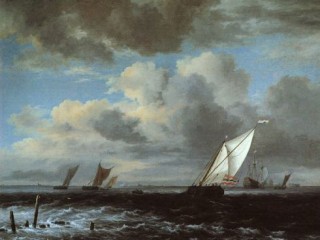
Jacob Van Ruisdael biography
Date of birth : -
Date of death : -
Birthplace : Harlem, New York, United States
Nationality : American
Category : Historian personalities
Last modified : 2011-07-04
Credited as : Landscape painter, ,
Jacob van Ruisdael was born in Haarlem, the son of the painter Isaak van Ruisdael, whose works are unknown to us, and the nephew of the gifted landscape painter Salomon van Ruysdael. Jacob's youthful works reflect the influence of his uncle and other painters of the Haarlem school, who played a leading part in the development of Dutch realistic landscape painting from the early years of the 17th century. He was already an independent master by 1648, when he became a member of the Haarlem guild. Paintings dated as early as 1645 and 1646 confirm that he was an accomplished painter while still very young.
The flat countryside around his native town provided subject matter for Ruisdael's brush again and again. Within the area of a small canvas, the level fields, on which the linen cloth that was a major product of Haarlem was stretched out to bleach, appear to extend on both sides as far as the eye can see. Cloud formations dapple the fields with sunlight. On the distant horizon, the buildings of the town join earth to sky. Such a picture is based on nature, but with the elements selected, emphasized, and reorganized so that the natural scene is transformed into an esthetic unity. It is a poetic transfiguration of reality.
Shortly after 1650 Ruisdael became familiar with a different kind of landscape, hilly and wooded, through travels in the border areas of eastern Holland and western Germany. Reminiscences of this experience appear in many of his paintings. In the Wooden Bridge (1652) a new monumentality is incorporated into a rugged landscape, whose structural strength is characteristic of Dutch painting about 1650. Ruisdael enriched the basic framework of the composition with a remarkable counterpoint of gently undulating contours, in which the curves of the meandering river, the paths, hills, clouds, and branches and crowns of trees underline, echo, and complete one another. The oak tree that dominates the left side of the composition is full of vitality and individuality. The richness of color and plasticity of forms of his mature works are evident here.
About 1656 Ruisdael moved to Amsterdam, where he seems to have spent the rest of his life. His extraordinary gift for evoking a higher reality in nature was embodied in a series of masterpieces. The brooding, emotion-filled Cemetery, or Jewish Cemetery at Ouderkerk (ca. 1660; two versions), is unique in its explicitly allegorical intent. Death and the destruction of both natural and man-made objects is contrasted with the rainbow, symbol of resurrection. The preparatory drawings that he made for this painting show that the tombs were drawn from observation, the landscape background was imaginary, and the architecture was altered from a simple country church to a romantic ruin.
Paintings by his friend Allaert van Everdingen, who had traveled in Scandinavia, probably provided the vocabulary of rocky mountain streams and fir trees that began to appear in Ruisdael's paintings about 1660. These compositions tend to heroic grandeur, sometimes overstated. The Waterfall with Castle (mid-1660s) is an example of Ruisdael at his best in this type of theme, with an almost tangible differentiation of the textures of various materials, dramatic contrasts of light and dark, and intense local color, unified by firm compositional control.
Ruisdael painted as many as 50 seascapes, beginning in the mid-1660s. In these his energetic brushstroke and strongly contrasted values are particularly effective. This can be seen in Stormy Sea (ca. 1670), which might be called a portrait of the wind as it is reflected in sea and sky. He also painted forests, beaches, snow scenes, and town views. The figures in his paintings were often added by another artist. A number of drawings and some etchings by Ruisdael, mainly antedating 1650, have also come down to us.



















